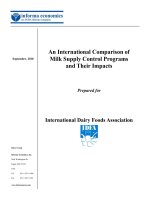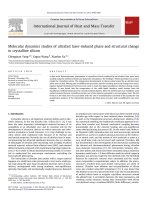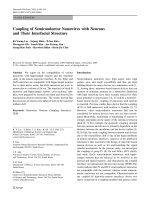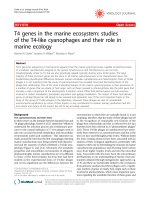Studies of electrodes modified with zeolites and poly(4 nitro 2 phenylenediamine) and their composite 3
Bạn đang xem bản rút gọn của tài liệu. Xem và tải ngay bản đầy đủ của tài liệu tại đây (201.97 KB, 19 trang )
ACKNOWLEDGEMENTS
I am indebted to my supervisor, Dr. Khoo Soo Beng for his utmost
patience, constant guidance and encouragement throughout the course of
this project.
Special thanks are given to my fellow researchers in the laboratory,
Ms. Fathima Shahitha and Chen Fang for their selfless assistance and
valuable suggestions given to me during this project.
The provision of Research Scholarship from the National
University of Singapore is gratefully acknowledged.
i
CONTENTS
Pages
Acknowledgements i
Table of Contents ii
Summary vii
List of Figures ix
List of Tables xix
Chapter I Introduction 1
1.1 Preparation of chemically modified electrodes 4
1.1.1 Electrodes modified with monomolecular layers 4
1.1.1.1 Chemisorption 4
1.1.1.2 Covalent bonding 4
1.1.1.3 Hydrophobic Layers 5
1.1.2 Electrodes modified with multimolecular layers 6
1.1.2.1 Polymers 6
1.1.2.2 Inorganic films 10
1.1.3 Electrodes modified with spatially defined and
heterogeneous layers 11
1.2 Characterization and analysis of chemically modified electrodes 15
1.2.1 Electrochemical methods 15
1.2.2 Spectroscopy and microscopy methods 18
1.2.3 Quartz crystal microbalance 19
1.3 Applications of chemically modified electrodes 21
1.3.1 Chemical sensors 21
ii
1.3.2 Energy-producing devices 22
1.3.3 Electrochromic devices 22
1.3.4 Fundamental chemistry 23
1.4 The objectives of the thesis 25
References 28
Chapter II Studies of zeolite modified electrodes fabricated by electrophoretic
deposition
35
2.1 Introduction 36
2.2 Experimental 39
2.2.1 Reagents 39
2.2.2 Apparatus 40
2.2.3 Procedure 40
2.3 Results and discussion 43
2.3.1 Zeolite modified electrode fabricated by dc voltage EPD 43
2.3.1.1 Effect of the supporting electrolyte concentration 43
2.3.1.2 Effects of dc voltage and time 44
2.3.1.3 Effects of different supporting electrolytes and solvent
48
2.3.2 Zeolite modified electrode fabricated by pulsed voltage EPD
52
2.3.3 Stability and applicability of zeolite modified electrode
fabricated by pulsed EPD 56
2.4 Conclusions 62
References 63
Chapter III Electropolymerization of 4-nitro-1,2-phenylenediamine and
iii
electrochemical studies of poly(4-nitro-1,2-phenylenediamine) films
65
3.1 Introduction 66
3.2 Experimental 68
3.2.1 Reagents 68
3.2.2 Apparatus 68
3.2.3 Procedure 68
3.3 Results and discussion 70
3.3.1 Electropolymerization of 4NoPD 70
3.3.2 Electrochemical characterization of P4NoPD films 74
3.3.2.1 Films formed using different cycles and different
supporting electrolytes 74
3.3.2.2 Scan rate studies 76
3.3.2.3
Stability of P4NoPD film 76
3.3.2.4 pH effect 77
3.3.3 Reduction of the nitro-groups of 4NoPD monomer 80
3.3.4 Electrochemical behaviors of the nitro-groups of P4NoPD
film 83
3.4 Conclusions 93
References 94
Chapter IV Electrochemical impedance spectroscopic studies of poly(4-nitro
1,2-phenylenediamine) film modified electrodes 97
4.1 Introduction 98
4.2 Experimental 100
4.2.1 Reagents 100
iv
4.2.2 Apparatus 100
4.2.3 Procedure 100
4.3 Results and discussion 102
4.3.1 P4NoPD film in 0.50 M H
2
SO
4
102
4.3.2 P4NoPD films formed in different numbers of cycles 109
4.3.3 pH effect
113
4.3.4 Effect of the reduction of nitro-groups of P4NoPD film 114
4.4 Conclusion 122
Reference 123
Chapter V Studies of electrodes modified with poly(4-nitro-1,2-
phenylenediamine) / zeolite composite 125
5.1 Introduction 126
5.2 Experimental 128
5.2.1 Reagents 128
5.2.2 Apparatus 128
5.2.3 Procedure 129
5.3 Results and discussion 131
5.3.1 Characterization of the composites in the media (pH=2) 133
5.3.2 Characterization of the composites in the media containing
redox active species 137
5.3.2.1 Effect of the amount of zeolites 142
5.3.2.2 pH effect 145
5.3.2.3 Accumulation of Fe(CN)
6
3-
147
5.3.2.4 Effect of redox active species 147
5.4 Conclusions 154
v
References 155
Future work 157
List of publications 158
vi
SUMMARY
In recent years, a number of works have devoted to the preparation,
characterization, and electrochemical behavior of chemically modified electrodes
(CMEs). In the 1960s, interest arose in the modification of electrode surfaces by
covalent attachment of monolayers to electrode surfaces. Electrodes modified with
thicker polymeric films and inorganic layers were introduced later. Here we discuss
the chemical and physical routes for the preparation of CMEs and the electrochemical
and other consequences of this.
Early fabrication of zeolite modified electrodes (ZMEs) generally has been
plagued by poor reproducibility, lack of mechanical robustness in a stirred solution,
and nonideal electrochemical behavior. Therefore, controllable formation of zeolite
thin film needs new processing schemes to improve quality and reproducibility.
We
have shown here the applicability of a novel approach to controllable zeolite
deposition on electrode surface by pulsed electrophoretic deposition. While dc
electrophoretic deposition also affords control of zeolite deposition, it is less tuneable
and convenient as different solutions have to be used and, more importantly, at the
expense of electrode surface integrity. In contrast, pulsed EPD is simple, yet more
powerful and convenient to give control of the amount of zeolite deposited (from sub-
monolayer to multilayer) by tuning the pulse widths, heights and number of pulses.
With regard to stability of ZMEs, it is our view that long term stability, if the ZME is
going to be used and reused with washing, storage and exposure to the atmosphere, is
not viable without some means of support/anchoring.
Conducting polymers, in particular electrodes modified with conducting
polymer film, have enjoyed initial success and recently stimulated extensive activities.
New types of polymer materials are still being developed to meet the challenges in the
vii
wide range of areas. Here, we have shown the anodic electropolymerization of 4-
nitro-1,2-phenylenediamine (4NoPD), which is dependent on the acidity as well as the
nature of anions in supporting electrolyte. It is essential to know and understand the
properties of poly(4-nitro-1,2-phenylenediamine) (P4NoPD) film (i.e. film
conductivity, charge-carrier transfer parameters, capacitance, etc) and the effects of
various factors (pH, film thickness, nitro-groups) on these properties. Therefore, we
applied the electrochemical studies of P4NoPD film under different conditions. The
P4NoPD film was confirmed to have conductivity which was highly electroactive
behavior, dependent on film thickness, acidity of the solution and the redox state of
the film. Also, film properties (film resistance, low-frequency capacitance, and
charge-carrier diffusion coefficient) were influenced by the presence of the electron-
withdrawing nitro-groups.
Finally, we have shown the applicability of a novel approach to composite
P4NoPD and EPD zeolite film on electrode surface. The results proved the
dependence of the properties of the composite film on the amount of zeolites. In
addition, the electrochemistry of the composite films in the presence of different
redox active probes was studied under the present experimental conditions. All of
these techniques give the consistent result that the novel properties of composite films
can be derived from the successful combination of the characteristics of P4NoPD and
zeolite 13X.
viii
List of Figures
Pages
Figure 2.1 SEM images of dc voltage EPD fabricated in 3.00 g l
-1
suspension of 46
zeolite 13X, 10
-5
M KNO
3
for 30 min:
(a) E=1.9 V; (b) E=2.0 V; (c) E=2.2 V; (d) E=2.5 V.
Figure 2.2 CVs (50 mV s
-1
) in 1.00 mM Fe(CN)
6
3-
, 1.00 M KCl: (a) bare 47
GCE, no EPD; (b) EPD in 3.00 g l
-1
suspension of zeolite
13X, 10
-5
M KNO
3
at 2.2 V for 30 min; (c) EPD in 3.00 g l
-1
suspension of zeolite 13X, 10
-5
M KNO
3
by pulsed voltage
(E
1
=0 V, t
1
=50 s, E
2
=2 V, t
2
=200 s, 10 steps).
For (b) and (c), the CVs were obtained after removing the
deposited zeolite particles by rinsing strongly and copiously
with Millipore water. While (b) and (c) are for close to
monolayer depositions, similar results were obtained for all
levels of depositions studied.
Figure 2.3 (a) Typical SEM image of dc EPD fabricated in 3.00 g l
-1
49
suspension of zeolite 13X, 10
-5
M KNO
3
at +4.50 V for 40 s;
(b) amplified image of the selected area.
Figure 2.4 Pulse Waveform 53
Figure 2.5 SEM images of pulsed EPD fabricated in 3.00 g l
-1
suspension 55
of zeolite 13X, 10
-5
M KNO
3
for 30 min.: (a) E
1
=0 V, t
1
=50 s,
E
2
=2 V, t
2
=190 s; (b) E
1
=0 V, t
1
=50 s, E
2
=2 V, t
2
=200 s; (c)
E
1
=0 V, t
1
=20 s, E
2
=2 V, t
2
=200 s; (d) E
1
=0 V, t
1
=30 s, E
2
=2
V, t
2
=190 s; In all cases, the number of steps was 10.
ix
Figure 2.6
CVs (50 mV s
-1
) at ZME (E
1
=0 V, t
1
=20 s, E
2
=2 V, t
2
=200 s, 58
10 steps, multilayer) in 1.00 mM Fe(CN)
6
3-
, 0.10 M KNO
3
after accumulation in the same solution (stirred): first scan
(⎯); second scan ( ). The CVs of (a)-(g) are time series, and
(h) CV at the bare GCE
Figure 3.1 CVs (50 mV s
-1
) at the Au electrode in 0.50 M H
2
SO
4
solution, 71
containing 4.50 mM 4NoPD, between -0.15 V and +1.10 V.
The cycles shown are numbers 1, 10, 15, 20, and 25 (being the
last cycle).
Figure 3.2 Plot of i vs. t
-1/2
for the chronoamperometric response at the 73
Au electrode in 0.50 M H
2
SO
4
containing 0.05 mM 4NoPD.
The potential was stepped from 0.4 V to 1.0 V.
Figure 3.3 (a) CVs (50 mV s
-1
) of three P4NPoD films on Au electrodes 75
(electropolymerizations were performed in 0.50 M H
2
SO
4
containing 4.50 mM 4NoPD) in 0.50 M H
2
SO
4
solution: 25-
cycles film (―); 40-cycles film ( ); 70-cycles film (
····
).
(b) CVs (50 mV s
-1
) in 0.50 M H
2
SO
4
for three P4NPoD films,
electropolymerized in different H
2
SO
4
-Na
2
SO
4
solutions
containing 4.50 mM 4NoPD on Au electrodes: 0.10 M H
2
SO
4
-
0.40 M Na
2
SO
4
(―); 0.20 M H
2
SO
4
-0.30 M Na
2
SO
4
( );
0.50 M H
2
SO
4
(
····
).
Figure 3.4 Plots of anodic peak currents i
p.a
of P4NoPD films on Au 78
electrodes (25-cycles, fabricated in 4.50 mM 4NoPD in 0.50 M
H
2
SO
4
) under different time and storage regimes:
x
(a) continuous cycling in 0.50 M H
2
SO
4
; (b) in between CVs in
0.50 M H
2
SO
4
, electrode was stored in 0.50 M H
2
SO
4
; (c) in
between CVs in 0.50 M H
2
SO
4
, electrode was stored in
Millipore water.
In all cases, the scan rate was 50 mV s
-1
.
Figure 3.5 Plots of anodic peak potential E
p.a
(mV) of P4NoPD film at 79
different pH values, scan rate: 50 mV s
-1
in sulfate solution (¡)
and in phosphate buffer (c). The ion strength of these
solutions is ca. 0.2.
Figure 3.6 CVs of the reduction of the nitro-groups of 4.50 mM 4NoPD monomer 84
in 0.50 M H
2
SO
4
at the GCE for 3 successive cycles: first cycle
(―); second cycle ( ); third cycle (
····
). The scan rate was 50
mV s
-1
.
Figure 3.7 CVs of the reduction of nitro-groups of P4NoPD film on GCE 85
(formed with 25 cycles in 4.50 mM 4NoPD in 0.50 M H
2
SO
4
)
in 0.50 M H
2
SO
4
for 3 successive cycles: first cycle (―);
second cycle
( ); third cycle (
····
). The scan rate was 50 mV s
-1
.
Figure 3.8 Redox peaks for the P4NoPD film (25 cycles in 4.50 mM 87
4NoPD in 0.50 M H
2
SO
4
) in 0.50 M H
2
SO
4
; comparison of
fresh film (―) with a film in which nitro-groups had been
reduced in 0.150 M H
2
SO
4
(see Figure 3.7) ( ).
CVs were obtained at 50 mV s
-1
.
Figure 3.9 (a) CVs (50 mV s
-1
) of the P4NoPD film (25 cycles in 4.50 mM 88
xi
4NoPD in 0.50 M H
2
SO
4
) on GCE in: 0.10 M NaOH (―); 1.00
M NaOH ( ).
(b) CVs (50 mV s
-1
) of the P4NoPD film (as above) on GCE in
0.50 M H
2
SO
4
, comparison of fresh film (―) and film after
reduction of nitro-groups in 1.00 M NaOH ( ).
Figure 3.10 (a) CV (50 mV s
-1
) of P4NoPD film (25 cycles in 4.50 mM 91
4NoPD in 0.50 M H
2
SO
4
) on GCE in 0.10 M Na
2
SO
4
(pH = 5.41): first cycle (―); second cycle ( ); (3) third cycle
(
····
).
(b) CVs (50 mV s
-1
) of P4NoPD films (as above) on GCE in
the sulfate media of different pH for first cycle: pH = 0.30 (―);
pH= 5.41 (-
·
-
·
-
·
-); pH = 7.90 ( ); pH = 11.00 (
····
).
Figure 4.1 The impedance spectra of P4NoPD film (formed with 25 103
cycles in 4.50 mM 4NoPD in 0.50 M H
2
SO
4
) on GCE in 0.50
M H
2
SO
4
: (a)-0.20 V; (b) 0.00 V; (c) 0.20 V.
A 5 mV amplitude sine wave at the frequency of 20K was used
as perturbation signal.
Figure 4.2 The equivalent circuit for the polymer modified electrode: 104
(a) simple model; (b) modified model [23].
R
u
is the ohmic resistance of the electrolyte and the surface
layer, C
dl
is the double-layer capacitance, R
ct
is the charge
transfer resistance, Z
D
is the diffusion impedance, C
o
is a
constant capacitance and CPE is a constant phase element.
Figure 4.3 Comparison of the measured impedance spectra (points) 107
xii
obtained from Figure 4.1(a) with simulated curves based on the
model in Figure 4.2(b) (solid line): (a) Nyquist plot; (b) Bode
plot.
The values used for the simulations: R
u
(5.2 ohm); C
dl
(2.1 µF);
R
ct
(18 ohm); C
o
(7.8 mF); CPE, Z
cpe
= (1/ 6.2 × 10
-4
) (jω)
–0.31
;
Z
D
= (510/(jω)
0.5
) coth(2 × 10
-2
(jω)
0.5
)
Figure 4.4 (a) Plot of film resistance (R
p
) for three P4NPoD films on GCEs 111-112
(formed in 0.50 M H
2
SO
4
containing 4.50 mM 4NoPD) in
0.50 M H
2
SO
4
solution.
(b) Plot of the charge transport diffusion coefficient (D) for
three P4NPoD films on GCEs (formed in 0.50 M H
2
SO
4
containing 4.50 mM 4NoPD) in 0.50 M H
2
SO
4
solution.
(c) Plot of low-frequency capacitance (C
L
) for three P4NPoD
films on GCEs (formed in 0.50 M H
2
SO
4
containing 4.50 mM
4NoPD) in 0.50 M H
2
SO
4
solution.
For all these diagrams, a 5 mV amplitude sine wave at the
frequency of 20K was used for resistance measurements: 25-
cycles film (♦); 40-cycles film (•); 70-cycles film (c).
Figure 4.5 (a) Plot of the low-frequency capacitance (C
L
) for P4NoPD film 115-116
on GCE (formed with 25 cycles in 4.50 mM 4NoPD in 0.50 M
H
2
SO
4
) in different H
2
SO
4
-Na
2
SO
4
solutions.
(b) Plot of film resistance (R
p
) for P4NoPD film on GCE
(formed with 25 cycles in 4.50 mM 4NoPD in 0.50 M H
2
SO
4
)
in different H
2
SO
4
-Na
2
SO
4
solutions on GCE. For resistance
xiii
measurements, a 5 mV amplitude sine wave at the frequency of
20K was used.
(c) Plot of the charge transport diffusion coefficient (D) for
P4NoPD film on GCE (formed with 25 cycles in 4.50 mM
4NoPD in 0.50 M H
2
SO
4
) in different H
2
SO
4
-Na
2
SO
4
solutions.
For all above diagrams: 0.01 M H
2
SO
4
-0.49 M Na
2
SO
4
(c)
(pH=4.0); 0.10 M H
2
SO
4
-0.40 M Na
2
SO
4
(•) (pH=1.7); 0.40 M
H
2
SO
4
-0.10 M Na
2
SO
4
H
2
SO
4
(♦) (pH=0.8).
Figure 4.6 Bode plots for P4NoPD film (25 cycles in 4.50 mM 4NoPD 117
in 0.50 M H
2
SO
4
) in 0.50 M H
2
SO
4
at 0.00 V.
Comparison of fresh film (a) with a film (b) in which nitro-
groups had been reduced in 0.50 M H
2
SO
4
Figure 4.7 (a) Plot of the low-frequency capacitance (C
L
) for the P4NoPD 119-120
film (formed with 25 cycles in 4.50 mM 4NoPD in 0.50 M
H
2
SO
4
) in 0.50 M H
2
SO
4
.
(b) Plot of film resistance (R
p
) for the P4NoPD film (25 cycles
in 4.50 mM 4NoPD in 0.50 M H
2
SO
4
) in 0.50 M H
2
SO
4
. For
resistance measurements, a 5 mV amplitude sine wave at the
frequency of 20 kHz was used.
(c) Plot of the charge transport diffusion coefficient (D) for the
P4NoPD film (25 cycles in 4.50 mM 4NoPD in 0.50 M H
2
SO
4
)
in 0.50 M H
2
SO
4
.
Comparison of fresh film (•) with a film (▲) in which nitro-
groups had been reduced in 0.50 M H
2
SO
4
for diagrams.
xiv
Figure 5.1 (a) SEM images of pulsed EPD fabricated in 3.00 g l
-1
132
suspension of zeolite 13X, 10
-5
M KNO
3
for 30 min:
(i) submonolayer, E
1
=0 V, t
1
=50 s, E
2
=2 V, t
2
=200 s; (ii)
monolayer, E
1
=0 V, t
1
=20s, E
2
=2 V, t
2
=200 s; (iii) multiplayer,
E
1
=0 V, t
1
=30 s, E
2
=2 V, t
2
=190 s. In all cases, the number of
steps was 10.
(b) SEM images of the composite films: (i) submonolayer
coated by P4NoPD; (ii) monolayer coated by P4NoPD; (iii)
multilayer coated by P4NoPD. P4NoPD films were formed on
the freshly prepared EPD through continuous potential cycling
between –0.15 V and +1.10 V at 20 mV s
-1
for 50 cycles in
0.50 M HNO
3
(pH = 2.00, adjust pH with KOH) containing
4.00 mM 4NoPD.
Figure 5.2 CVs (50 mV s
-1
) of the P4NoPD film (⎯) and the composite 134
films in 0.10 M KNO
3
(pH = 2.00, adjusted by HNO
3
). The
P4NoPD film was prepared in solution containing 4.50 mM
4NoPD, 0.50 M HNO
3
(pH = 2.00, adjusted by KOH). In all
above diagrams: submonolayer zeolite EPD coated by P4NoPD
film ( ); monolayer zeolite EPD coated by P4NoPD film
(⋅⋅⋅⋅⋅); multilayer zeolite EPD coated by P4NoPD film (-⋅-⋅-⋅-).
Figure 5.3 CVs (50 mV s
-1
) of reduction of nitro-groups of the P4NoPD film 136
(⎯) and the composite films (Figure 5.2) in 0.10 M KNO
3
(pH
= 2.00, adjusted by HNO
3
). In all above diagrams:
submonolayer zeolite EPD coated by P4NoPD film ( );
xv
monolayer zeolite EPD coated by P4NoPD film (⋅⋅⋅⋅⋅);
multilayer zeolite EPD coated by P4NoPD film (-⋅-⋅-⋅-).
Figure 5.4 Resistance data
a
of P4NoPD film
b
(♦) and the composite film
c
(▲) 138
in 0.10 M KNO
3
(pH = 2.00, adjusted by HNO
3
).
a
resistance obtained using a 5 mV amplitude sine wave at the
frequency of 20K.
b
the P4NoPD film was prepared in solution containing 4.00
mM 4NoPD and 0.50 M HNO
3
(pH = 2.00, adjusted by KOH).
c
the composite film was prepared by multilayer zeolite EPD
coated by P4NoPD film.
Figure 5.5 CVs of the composite film (multilayer zeolite EPD coated 140
by P4NoPD film) in contact with 0.10 M KNO
3
(pH = 2.00)
(⎯)
and 1.00 mM Fe(CN)
6
3-
, 0.10 M KNO
3
(pH = 2.00) ( ).
Figure 5.6 Typical impedance diagrams of the composite film (multilayer 141
zeolite EPD coated by P4NoPD film) in 0.10 M KNO
3
(pH =
2.00, adjusted by HNO
3
) (o)
and 0.10 M KNO
3
(pH = 2.00)
containing 1.00 mM Fe(CN)
6
3-
, (+):
(a) -0.35V; (b) -0.20V; (c) 0.05V.
Figure 5.7 CVs (50 mV s
-1
) of bare GC electrode (a), monolayer zeolite 143-144
EPD (b), pure P4NoPD film (c), and the composite films: (d)
submonolayer zeolite EPD coated by P4NoPD film; (e)
monolayer zeolite EPD coated by P4NoPD film; (f)
multilayer zeolite EPD coated by P4NoPD film. The solution
is 0.10 M KNO
3
(pH = 2.00, adjusted by HNO
3
) containing
1.00 mM Fe(CN)
6
3-
.
xvi
Figure 5.8 CVs (50 mV s
-1
) of the composite film (multilayer zeolite 146
EPD coated by P4NoPD film) in various pH of 1.00 mM
Fe(CN)
6
3-
, 0.10 M KNO
3
, and pH values were adjusted by
HNO
3
: (a) pH = 2.00; (b) pH = 3.00; (c) pH = 4.80.
Figure 5.9 (a) CVs (50 mV s
-1
) of the composite film (multilayer zeolite 148
EPD coated by P4NoPD film) in 1.00 mM Fe(CN)
6
3-
, 0.10 M
KNO
3
(pH = 2.00, adjusted by HNO
3
), after the composite
film was kept at –0.40 V for different periods prior to
scanning: 10 s (····); 100 s ( ); 1800 s (⎯).
(b) Plot (50 mV s
-1
) of the anodic peak charges Q
p1,a
of the
composite film (multilayer zeolite EPD coated by P4NoPD
film) in 1.0 mM Fe(CN)
6
3-
, 0.10 M KNO
3
(pH = 2.00,
adjusted by HNO
3
), after the composite film was kept at –
0.40 V for different periods prior to scanning.
Figure 5.10 CVs (50 mV s
-1
) of the composite film (multilayer zeolite 149
EPD coated by P4NoPD film) in 0.10 M KNO
3
(pH = 2.00,
adjusted by HNO
3
), the electrolyte solution, containing: (a)
1.00 mM Fe(CN)
6
3-
; (b) 1.00 mM Ru(NH
3
)
6
3+
; (c) 1.00 mM
hydroquinone; In all curves, solid line is on the composite
film, and dash line is on the bare GCE.
Figure 5.11 Plots of anodic peak potential separation ∆Ep=E
p1,a
– E
p1,c
(mV) 151
of HQ/Q versus scan rate v (mV s
-1
) on the bare GCE (•)
and the composite film (multilayer zeolite EPD coated by
P4NoPD film) (
▲) in 0.10 M KNO
3
(pH = 2.00, adjusted
by HNO
3
) containing 1.00 mM HQ.
xvii
Figure 5.12 CVs (50 mV s
-1
) of the composite films (multilayer zeolite 152
EPD coated by P4NoPD film) in 1.00 mM HQ, 0.10 M
KNO
3
(pH = 2.00, adjusted by HNO
3
), after the composite
film was kept at –0.40 V for different periods prior to
scanning: 10 s (····); 100 s ( ); 1800 s (⎯).
xviii
List of Tables
Pages
Table 2.1 Solution/suspension parameters and their effects on dc EPD 45
Table 2.2 Effect of different supporting electrolytes on dc EPD 50
Table 2.3 Cathodic and anodic charges from CVs (50 mV s
-1
) of bare GCE 60
and ZME* in 1.00 mM Cu
2+
, 0.10 M KNO
3
after the preconcentrations for
different periods in the same solution.
Table 3.1 Peak potentials and currents for CVs of P4NoPD film
*
on Au 81
electrode in sulfate solutions of different pH values.
*
electropolymerized in 0.50 M H
2
SO
4
containing 4.50 mM 4NoPD with 25
cycles
Table 3.2 Resistance data
a
of P4NoPD film
b
on Au electrode at the peak 82
potentials of their respective CVs in sulfate solutions of different pH.
a
resistance obtained using a 5 mV amplitude sine wave at the frequency of
20K.
b
electropolymerized in 0.50 M H
2
SO
4
containing 4.50 mM 4NoPD with 25
cycles.
Table 4.1 Impedance data for the P4NoPD film
a,b
110
a
electropolymerization in 4.50 mM 4NoPD in 0.50 M H
2
SO
4
for 25 cycles
b
data obtained from Figure 4.1, obtained from the respective modified
electrode in 0.50 M H
2
SO
4
xix









